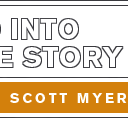Studies in Flashbacks: “Casablanca”
Part 1 of a five-part series on movies where flashbacks work.
I set this discussion into motion here and here. To wit: Hollywood conventional wisdom is that voice-over narration and flashbacks are a no-no, yet some of the greatest movies ever produced use these narrative devices including Fight Club, Goodfellas, The Silence of the Lambs, and Rashomon.
My conclusion: Voice-over narration and flashbacks are not inherently bad, rather they are tainted by how poorly they get executed by inexperienced writers.
Goal: Find five movies in which each is used well, then analyze those movies to come up with — hopefully — guidelines on how best to handle this pair of narrative devices.
Today the first of five movies which use flashbacks: Casablanca, the famous 1942 movie, screenplay by Julius Epstein & Philip Epstein and Howard Koch, play by Murray Burnett and Joan Allison.
Setup: Out of nowhere Ilsa Lund has reappeared in Rick’s life. He gets good and drunk, then remembers key events from his past that broke his heart, a sequence known as the Paris montage. Here is a breakdown of the scenes:
- The Arc de Triomphe
- Rick and Ilsa driving in a car
- An excursion boat on the Seine
- Rick’s Paris apartment
- A Paris cafe
- Newsreel footage: German occupation of France
- Paris cafe: Germans will enter the city soon
- La Belle Aurore: Drinking champagne, Ilsa’s mood is unsettled, plans to meet at the train station
- Gare De Lyon train station: In the rain, Rick receives a note from Ilsa. It reads:
“Richard, I cannot go with you or see you again. You must not ask why. Just believe that I love you. Go, my darling, and God bless you. Ilsa”
Stunned Rick tosses the letter aside as the train pulls away.
Here is part of the sequence:
The entire sequence is 8 pages long in the script. All of it flashbacks. Why does it work? Here are two takeaways:
- The sequence has a beginning, middle and end, a well-structured montage.
- Most importantly the sequence answers a critical question: What the hell happened between Rick and Ilsa?
So if your story needs an extended flashback sequence, make sure it has a strong structure, and serves a necessary and important function in the story. You’re probably in the ballpark if you’re working with a mystery where the answers gets revealed.
Okay, I can hear some of you: “Casablanca is an OLD movie. Maybe flashbacks worked back then, but not in contemporary movies.”
Uh, wrong.
Tomorrow: The Social Network.
And remember, use flashbacks if they are the only and best way to tell your story.
